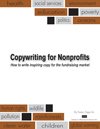According to the IRS there are about 1.8 million nonprofits in the United States alone. The question is: How many can survive for the next few years and beyond?
Marcia Stepanek has a pointed view on the subject in her Cause Global blog – “Are charities becoming obsolete?” I recommend you read it. But first, I have comments to share on four of her points.
“… as the nonprofit charity sector enters its third year of steep declines in donor dollars, a new question is dominating the conversation: are traditional, middleman charities—whose purpose has been to raise money for various causes and spend it as their boards see fit—becoming obsolete?
For some time now, philanthropy thought leaders have predicted that unless traditional charities fundamentally reinvent themselves as aggregators and issues experts—and retool their funding models—they could die trying.”
This is scary. And the reason I say it’s scary is because you might already be behind the power curve.

"La-la-la. If I don't see it or hear it then I'm okay."
For example: If you believe the only reason donations are down is because of the recession, then perhaps you’re pretending all is well except for the recession. I have the image of myself as a child closing my eyes, plugging my ears, and singing “la-la-la” to block out reality.
My point is that the issues of struggling acquisition campaigns, donations dropping, donor confidence declining, and retention falling are not due solely to the recession. This expression comes to mind:
If you’re not changing and growing … you’re dying.
Look beyond the recession for opportunities to revitalize your acquisition and fundraising efforts. Starting today . . . Take a long, hard, critical look at how your charity is operating. Where can you break the mold and venture into a brave new world?
And near and dear to my heart . . . how can you more effectively engage your donors; interact with them; write to them; and inspire them? How you communicate with donors – both the channels you use and the copy you write – is among the reasons nonprofits are either growing or dying.
And this takes us to the next point in Stepanek’s article:
“Many charities still are hard-pressed to innovate using Web tools, and it continues to spur wide-scale disintermediation; roles are being redefined, like it or not, in a world where it is now possible (and preferable in many cases) for supporters to “give direct”—with or without charities to guide them.”
If you are challenged by technology then outsource. Make room in your budget to get whatever help you need. I believe it’s a matter of survival for your charity.
This is one of the ways to keep your charity prospering for many years to come. Donors – including those well into their 50’s and 60’s – demand that you have a strong online presence. They demand that you are responsive to their preferences on how to communicate with them.
“Today’s charity squeeze also is a wake-up call around today’s ever-more urgent need to prove impact.”
I’m just one of many copywriters who have long been touting the importance of telling donors specifically how their money will be used. What will their donation accomplish? Exactly how will it help someone? This is important to low-dollar, mid-level, and major donors alike. Your copy must be donor-centered.
Stepanek’s article goes on to state that there may be too many “…niche nonprofits devoted to small slices of a problem ….” and they need to be merged.
I won’t get into the debate of whether you should merge with another nonprofit or not.
I can recommend you combine forces with complimentary (and perhaps non-competing) nonprofits whenever possible for special events, projects, and other fundraisers. Also look to associations as well as other charities for opportunities to combine forces.
The public views these cooperative efforts as smart ways to stretch dollars. Your efforts are viewed as making more funds available for the mission and doing good. And they’re right! Make a strong impression on donors and prospects with tactics like these.
Don’t become obsolete. Strategically think about how you can adapt to rapidly changing times.
And please share your thoughts. Are there too many charities with overlapping missions going after limited donor funds? Is it past time for reinventing the charitable fundraising model? How are you sending donors messages they want to receive?
Footnote: Here’s a resource to help your nonprofit make changes. Network for Good is presenting a free teleconference on Tues, Feb 23rd at 1pm Eastern Time.
Dan Heath, co-author of the new book –Switch: How to Change Things When Change Is Hard – is the guest speaker. Click here for details and to register.

{ 2 trackbacks }
{ 0 comments… add one now }